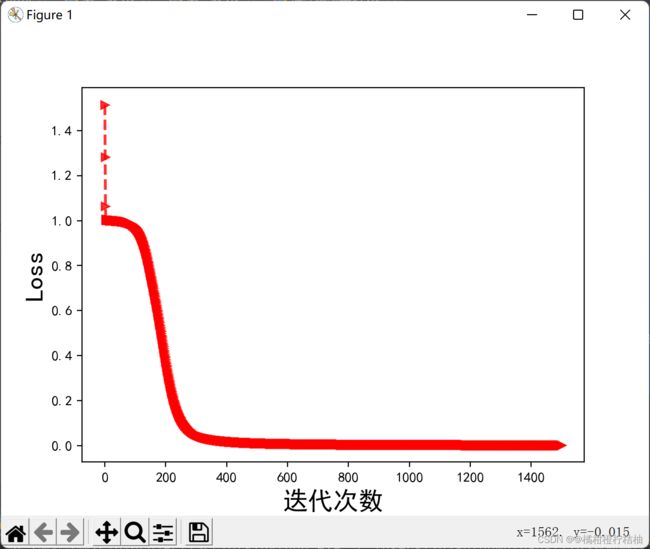运行结果:

Python代码实现 :
# coding=gbk
#====导入相关库==========
import numpy as np
import matplotlib.pyplot as plt
import matplotlib as mpl
mpl.rcParams['font.sans-serif'] = ['SimHei'] # 指定默认字体
#mpl.rcParams['font.sans-serif'] = ['Times New Roman'] #Times New Roman字体
mpl.rcParams['axes.unicode_minus'] = False # 解决保存图像是负号'-'显示为方块的问题
import matplotlib; matplotlib.use('TkAgg')
# 激活函数
def sigmoid(x):
return 1.0 / (1 + np.exp(-x))
#
def sigmoid_derivative(x):
return x * (1.0 - x)
# 计算损失函数
def compute_loss(y_hat, y):
return ((y_hat - y)**2).sum()
class NeuralNetwork:
def __init__(self, x, y):
self.input = x
# 它为每个输入创建 4 个介于 0 和 1 之间的随机数
self.weights1 = np.random.rand(self.input.shape[1], 4)
self.weights2 = np.random.rand(4, 1)
self.y = y
self.output = np.zeros(self.y.shape)
def feedforward(self):
self.layer1 = sigmoid(np.dot(self.input, self.weights1))
self.output = sigmoid(np.dot(self.layer1, self.weights2))
def backprop(self):
# application of the chain rule to find derivative of the loss function with respect to weights2 and weights1
d_weights2 = np.dot(self.layer1.T, (2 * (self.y - self.output) * sigmoid_derivative(self.output)))
d_weights1 = np.dot(self.input.T, (np.dot(2 * (self.y - self.output) * sigmoid_derivative(self.output),
self.weights2.T) * sigmoid_derivative(self.layer1)))
# update the weights with the derivative (slope) of the loss function
self.weights1 += d_weights1
self.weights2 += d_weights2
if __name__ == "__main__":
#===特征=======
X = np.array([[0, 0, 1],
[0, 1, 1],
[1, 0, 1],
[1, 1, 1]])
#====目标======
y = np.array([[0], [1], [1], [0]])
nn = NeuralNetwork(X, y)
loss_values = [] # 记录loss列表
for i in range(1500):
nn.feedforward()
nn.backprop()
loss = compute_loss(nn.output, y) # 计算loss
loss_values.append(loss)
print(nn.output) # 输出
print(f" final loss : {loss}") # 最终loss
# 可视化loss变化
plt.plot(loss_values,color='red',marker='>',linestyle='--',linewidth=2,alpha=0.8,label='loss')
plt.xlabel('迭代次数',fontsize=18) #fontsize=18 调整字大小
plt.ylabel('Loss',fontsize=18)
plt.show()
# coding=gbk
#====导入相关库==========
import numpy as np
import matplotlib.pyplot as plt
import matplotlib as mpl
mpl.rcParams['font.sans-serif'] = ['SimHei'] # 指定默认字体
#mpl.rcParams['font.sans-serif'] = ['Times New Roman'] #Times New Roman字体
mpl.rcParams['axes.unicode_minus'] = False # 解决保存图像是负号'-'显示为方块的问题
import matplotlib; matplotlib.use('TkAgg')
# 激活函数
def sigmoid(x):
return 1.0 / (1 + np.exp(-x))
#
def sigmoid_derivative(x):
return x * (1.0 - x)
# 计算损失函数
def compute_loss(y_hat, y):
return ((y_hat - y)**2).sum()
class NeuralNetwork:
def __init__(self, x, y):
self.input = x
# 它为每个输入创建 4 个介于 0 和 1 之间的随机数
self.weights1 = np.random.rand(self.input.shape[1], 4)
self.weights2 = np.random.rand(4, 1)
self.y = y
self.output = np.zeros(self.y.shape)
def feedforward(self):
self.layer1 = sigmoid(np.dot(self.input, self.weights1))
self.output = sigmoid(np.dot(self.layer1, self.weights2))
def backprop(self):
# application of the chain rule to find derivative of the loss function with respect to weights2 and weights1
d_weights2 = np.dot(self.layer1.T, (2 * (self.y - self.output) * sigmoid_derivative(self.output)))
d_weights1 = np.dot(self.input.T, (np.dot(2 * (self.y - self.output) * sigmoid_derivative(self.output),
self.weights2.T) * sigmoid_derivative(self.layer1)))
# update the weights with the derivative (slope) of the loss function
self.weights1 += d_weights1
self.weights2 += d_weights2
if __name__ == "__main__":
#===特征=======
X = np.array([[0, 0, 1],
[0, 1, 1],
[1, 0, 1],
[1, 1, 1]])
#====目标======
y = np.array([[0], [1], [1], [0]])
nn = NeuralNetwork(X, y)
loss_values = [] # 记录loss列表
for i in range(1500):
nn.feedforward()
nn.backprop()
loss = compute_loss(nn.output, y) # 计算loss
loss_values.append(loss)
print(nn.output) # 输出
print(f" final loss : {loss}") # 最终loss
# 可视化loss变化
plt.plot(loss_values,color='red',marker='>',linestyle='--',linewidth=2,alpha=0.8,label='loss')
plt.xlabel('迭代次数',fontsize=18) #fontsize=18 调整字大小
plt.ylabel('Loss',fontsize=18)
plt.show()
# coding=gbk
#====导入相关库==========
import numpy as np
import matplotlib.pyplot as plt
import matplotlib as mpl
mpl.rcParams['font.sans-serif'] = ['SimHei'] # 指定默认字体
#mpl.rcParams['font.sans-serif'] = ['Times New Roman'] #Times New Roman字体
mpl.rcParams['axes.unicode_minus'] = False # 解决保存图像是负号'-'显示为方块的问题
import matplotlib; matplotlib.use('TkAgg')
# 激活函数
def sigmoid(x):
return 1.0 / (1 + np.exp(-x))
#
def sigmoid_derivative(x):
return x * (1.0 - x)
# 计算损失函数
def compute_loss(y_hat, y):
return ((y_hat - y)**2).sum()
class NeuralNetwork:
def __init__(self, x, y):
self.input = x
# 它为每个输入创建 4 个介于 0 和 1 之间的随机数
self.weights1 = np.random.rand(self.input.shape[1], 4)
self.weights2 = np.random.rand(4, 1)
self.y = y
self.output = np.zeros(self.y.shape)
def feedforward(self):
self.layer1 = sigmoid(np.dot(self.input, self.weights1))
self.output = sigmoid(np.dot(self.layer1, self.weights2))
def backprop(self):
# application of the chain rule to find derivative of the loss function with respect to weights2 and weights1
d_weights2 = np.dot(self.layer1.T, (2 * (self.y - self.output) * sigmoid_derivative(self.output)))
d_weights1 = np.dot(self.input.T, (np.dot(2 * (self.y - self.output) * sigmoid_derivative(self.output),
self.weights2.T) * sigmoid_derivative(self.layer1)))
# update the weights with the derivative (slope) of the loss function
self.weights1 += d_weights1
self.weights2 += d_weights2
if __name__ == "__main__":
#===特征=======
X = np.array([[0, 0, 1],
[0, 1, 1],
[1, 0, 1],
[1, 1, 1]])
#====目标======
y = np.array([[0], [1], [1], [0]])
nn = NeuralNetwork(X, y)
loss_values = [] # 记录loss列表
for i in range(1500):
nn.feedforward()
nn.backprop()
loss = compute_loss(nn.output, y) # 计算loss
loss_values.append(loss)
print(nn.output) # 输出
print(f" final loss : {loss}") # 最终loss
# 可视化loss变化
plt.plot(loss_values,color='red',marker='>',linestyle='--',linewidth=2,alpha=0.8,label='loss')
plt.xlabel('迭代次数',fontsize=18) #fontsize=18 调整字大小
plt.ylabel('Loss',fontsize=18)
plt.show()
